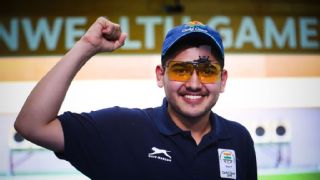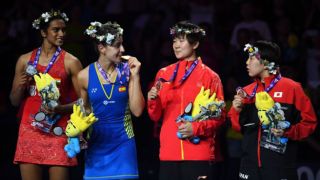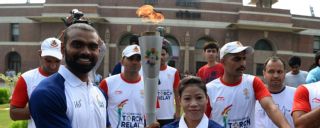|
It's not the kind of year most athletes would kill for. Two major tournaments - Commonwealth Games (CWG) and Asian Games - three months apart thrown into punishing calendars has them stretching their already war-torn bodies. Now the Asian Games are here and there's no getting away. Held two years before the Olympics, the Asian Games is a good way for athletes to size up against opponents in a wider, slightly more competitive setting than the CWG. In fact, in some disciplines the field is not just competitive, it's world-class. Let's start with shooting. All top six shooters in the 50m 3 positions women's event at the Munich World Cup in May this year were from Asia. Three of the top five nations which finished among medals at the weightlifting World Championships in December last year were Asian. In badminton, of the 32 World Championship medalists this year, women's singles gold medalist Carolina Marin was the only non-Asian. So you know just how competitive we're talking about. Athletics has traditionally been India's medal minefield at the Games, fetching a total of 233 medals (77 gold, 72 silver, 84 bronze) up until now and this time promises to be no different. Between javelin thrower Neeraj Chopra, middle-distance runner Hima Das, discus thrower Seema Punia and sprinter Dutee Chand, there is lots of hope. Double Asian Games gold medalist and former long jumper Anju Bobby George is willing to wage good money on India's prospects in the sprint and throw events. "Our chances are strong in discus and javelin throws and of course our sprinters are in good form," she says, "We could have done with better preparation in the jump events though. We have been winning track and field medals at the Asian Games for years together now so it's time we start aiming for bigger events like the Olympics." For a clearer insight into the level of competition, run a finger down the Rio Olympics' top track and field medalists and you'd find just one Asian nation - China - in the top ten. Then there is wrestling, boxing and shooting to make up the bulk of India's medal prospects and each hold out young, bankable names. Among them is 15-year old Anish Bhanwala who'd packed in his school books along with his gun when he'd left for the CWG; returning with a shiny metal disc tucked between them. With a record Games score in the 25m rapid fire pistol event, Anish became the youngest-ever Indian gold medalist at the CWG. A gilded CV brings with it the weight of great expectations and with some of the senior names like Jitu Rai and Gagan Narang missing out, this bunch of debutants - 29 of them in pistol and rifle events - are primary medal contenders and with that a new order appears to have discreetly replaced the old.  Former Asian Games gold medalist and pistol shooter Jaspal Rana pushes to free the young first-timers from the needless pressure. "The competition at Commonwealth Games is a lot easier than Asian Games, that's something we must bear in mind," he says, "These young shooters are a rare talent but they are not yet ready for the highest level. They should be given time to hone their skills. CWG and Asian Games are important but your preparation has to be from Olympics to Olympics." In wrestling, there's 24 year-old Bajrang Punia (64 kg), who's coming off a hat-trick of gold medals - Commonwealth Games, Yasar Dogu International in Turkey and Tbilisi GP in Georgia and on the other side of spectrum is 35 year-old double Olympic medalist Sushil Kumar (74 kg) who suffered his first defeat in four years in Georgia. He will be chasing more than just a medal. It will also be his chance to prove that his gold against a weak field at the Commonwealth Games was no blip. In badminton things are a bit tricky. India are alongside Japan, Korea and Indonesia in the top half of the women's draw, and they could meet doubles powerhouse Japan (ranked both No 1 & 2 in the world) in the quarterfinals following a first-round bye. In the previous edition, the Indian women's team, which included both Saina Nehwal and PV Sindhu, finished with a bronze.  The men's team event path looks relatively smoother. India will play Maldives in the first round and a win will set up quarterfinals against Indonesia. Before leaving for Jakarta, national coach Pullela Gopichand sounded reasonably optimistic. "We go in with a chance in every event and that's very rarely this happened with the Indian team. We hope that we do well at the Games although this been a tough year for us," he said before the draw. The individual event draws will only be out on August 22 following the completion of team competitions. India have never won a singles gold at the Games and Sindhu, who's in fine touch and coming off a World Championship silver, will be itching to change that. Even in the choice of disciplines it tests, the Asian Games are different. Apart from Olympic sports like tennis, golf, archery (which aren't part of Commonwealth Games), there's also room for seemingly peripheral sports (think sport climbing, kabaddi, karate). Sport climbing, which will be making a debut at the 2020 Olympics, in fact is making its appearance at this Games for the first time and India will find representation in a three-member team. Infrastructure, in this case, climbing walls, are largely owned by the country's armed forces and Maibam Chingkheinganba, who holds the national speed record of 7.2 seconds along with teammates Bharath Pereira and Shreya Nankar darted between training camps in New Delhi, Jamshedpur and Bhubaneswar in the run-up. Over the next fortnight, Indian sport fans will be following the journey of their favorite athletes from among a 572-member team, scouring for news of every medal won or narrowly missed. A South East Asian Games venue also means that it's easy on both the fan and casual viewer with no odd-hour matches and minimal time difference math. So, the Games are here. Let the medals flow.
|

